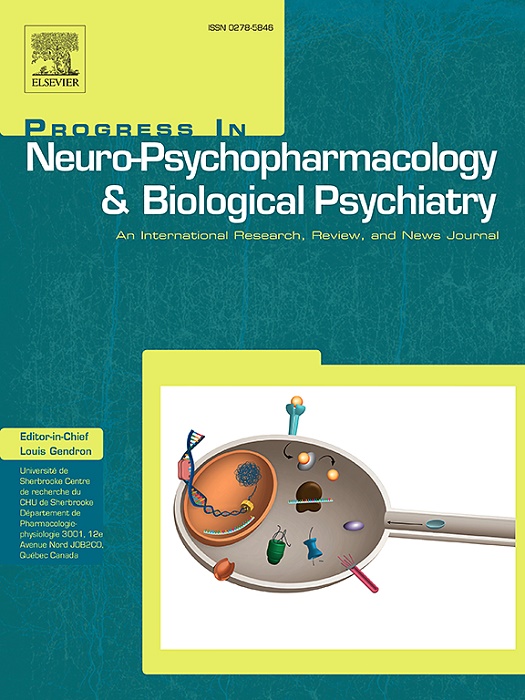抑郁症中神经递质介导的前额叶回路研究进展
IF 3.9
2区 医学
Q1 CLINICAL NEUROLOGY
Progress in Neuro-Psychopharmacology & Biological Psychiatry
Pub Date : 2025-08-21
DOI:10.1016/j.pnpbp.2025.111475
引用次数: 0
摘要
抑郁症是一种高度流行的神经精神疾病,其特征是持续情绪低落和快感缺乏,严重威胁人类健康。前额叶皮层(PFC)是控制情绪和认知调节的核心大脑区域,其神经回路功能失调是抑郁症发病的关键机制。本文综述了抑郁症中神经递质介导的pfc相关神经回路的研究进展。多巴胺(DA)通过腹侧被皮层- pfc和pfc -伏隔核等回路调节奖励处理和认知功能。这些回路中受体功能的异常导致PFC锥体神经元兴奋性的不平衡。谷氨酸(Glu)是主要的兴奋性神经递质,通过n -甲基-d-天冬氨酸/ α-氨基-3-羟基-5-甲基-4-异恶唑丙酸受体介导突触传递,包括内侧PFC (mPFC)和基底外侧杏仁核。5-羟色胺(5-羟色胺[5-HT])通过mpfc -中隔背核回路调节抑制性神经元,5-HT水平降低会加剧情绪障碍。γ -氨基丁酸(GABA)通过小白蛋白/生长抑素中间神经元维持PFC回路的稳定性,其功能障碍导致过度兴奋。此外,神经递质之间存在复杂的相互作用;例如,DA和Glu协同调节突触可塑性,而5-HT和GABA协调抑制平衡。这篇综述指出了当前研究中尚未解决的问题,包括不清楚的机制和异质性。未来的研究应探索神经递质相互作用和个体差异,为抑郁症的精确诊断和治疗提供理论依据。本文章由计算机程序翻译,如有差异,请以英文原文为准。
Advances in neurotransmitter-mediated prefrontal circuitry in depression
Depression, a highly prevalent neuropsychiatric disorder characterised by persistently low mood and anhedonia, poses a severe threat to human health. The prefrontal cortex (PFC), a core brain region governing emotional and cognitive regulation, exhibits dysfunctional neural circuitry that constitutes a key mechanism in the pathogenesis of depression. This article reviews neurotransmitter-mediated PFC-related neural circuits in depression. Dopamine (DA) modulates reward processing and cognitive functions through circuits such as the ventral tegmental area-PFC and PFC-nucleus accumbens. Aberrant receptor function within these circuits leads to imbalanced excitability of PFC pyramidal neurons. Glutamate (Glu), the primary excitatory neurotransmitter, mediates synaptic transmission via N-methyl-d-aspartate/ α-amino-3-hydroxy-5-methyl-4-isoxazolepropionic acid receptors in circuits including the medial PFC (mPFC) and basolateral amygdala. Its dysregulation disrupts the excitation–inhibition balance within the PFC. Serotonin (5-hydroxytryptamine [5-HT]) regulates inhibitory neurons through the mPFC-dorsal raphe nucleus circuit, and reduced 5-HT levels exacerbate emotional disturbances. Gamma-aminobutyric acid (GABA) maintains the stability of PFC circuits via parvalbumin/somatostatin interneurons, and its dysfunction causes excessive excitation. Furthermore, complex interactions exist between neurotransmitters; for instance, DA and Glu synergistically regulate synaptic plasticity, whereas 5-HT and GABA coordinate the inhibitory balance. This review identifies unresolved issues in current research, including unclear mechanisms and heterogeneity. Future studies should explore neurotransmitter interactions and individual differences to provide a theoretical basis for the precise diagnosis and treatment of depression.
求助全文
通过发布文献求助,成功后即可免费获取论文全文。
去求助
来源期刊
CiteScore
12.00
自引率
1.80%
发文量
153
审稿时长
56 days
期刊介绍:
Progress in Neuro-Psychopharmacology & Biological Psychiatry is an international and multidisciplinary journal which aims to ensure the rapid publication of authoritative reviews and research papers dealing with experimental and clinical aspects of neuro-psychopharmacology and biological psychiatry. Issues of the journal are regularly devoted wholly in or in part to a topical subject.
Progress in Neuro-Psychopharmacology & Biological Psychiatry does not publish work on the actions of biological extracts unless the pharmacological active molecular substrate and/or specific receptor binding properties of the extract compounds are elucidated.

 求助内容:
求助内容: 应助结果提醒方式:
应助结果提醒方式:


